"Dawn" Iranian MLRS
In connection with such problems, by the end of the eighties, several programs were deployed, which eventually resulted in the emergence of a family of multiple launch rocket systems called Fajr (translated from Arabic “dawn”). The first representative of the line - Fajr-1 - was first purchased from China, and then mastered in the production of towed MLRS "Type 63". On the two-wheeled system chassis, there was a launcher with twelve tubes of 107 caliber of millimeters. The rather simple design of the chassis and guidance system made it possible to rotate the package of barrels within the horizontal sector with a width of 32 ° and lower / raise the launch tubes at angles from -3 ° to + 57 °. If necessary, the design of the launcher allowed to mount it on any suitable chassis. Chinese Type-63 missiles in Iran received a new designation - Haseb-1. 19-kilogram ammunition at the optimum elevation angle flew over eight kilometers. By Iranian standards, this was not enough, which is why the Fajr-1 revision began. Updated Haseb missiles allowed to increase the firing range, but not to such indicators, which the military wanted.
Fajr-xnumx
Around the beginning of the nineties (exact information about the timing is not available), the Shahid Bagheri Industries Group and Sanam Industrial Group under the auspices of the state-owned Defense Industries Organization began work on a new salvo fire system, which planned to take into account all previous experience. The project received the designation Fajr-3. There is evidence that experts from North Korea took part in the creation of Dawn-3. Perhaps the Iranian military and engineers, working with the Chinese, came to certain conclusions and decided to change the country with which to work; However, a number of further events showed that, most likely, the Iranians simply decided to expand the number of joint projects. As a result of cooperation in the Fajr-3 salvo fire system, some features of the North Korean M1985 are clearly visible, in particular, the layout with the placement of an additional cab for the calculation in the middle part of the wheel chassis. For the first time, the existence of the MLRS Fajr-3 became known in 1996, when several such self-propelled units were shown at the parade in Tehran. It is noteworthy that those combat vehicles were built on the basis of a three-axle truck of the Japanese company Isuzu, which first served as the basis for the version about the simple purchase of systems from the DPRK, whose M1985 are based on such a chassis.
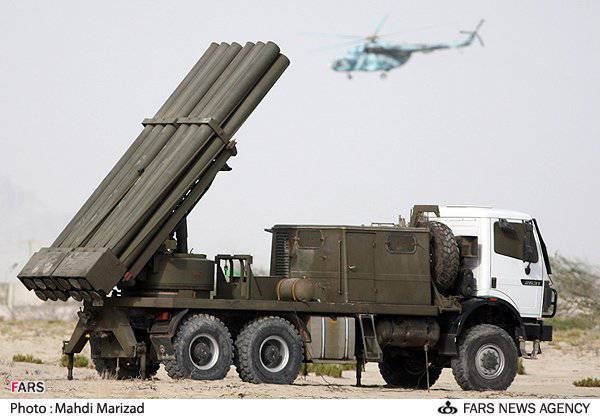
Further study of photographs and videos from that parade led Western experts to conclude that, at a minimum, cooperation. The fact is that the launch tubes of the Iranian Dawn-3 had a diameter twice as large as the Korean M1985 guides. It later became known that the caliber of Fajr-3 rockets is equal to 240 millimeters. Due to the larger gauge, the Fajr-3 system guide pack, with similar dimensions to Grad or M1985, consists only of 12 pipes. Structurally, the package is divided into two parts of six guides, each of which is attached to the frame separately. Guidance mechanisms are manual and allow elevation from zero to 57 degrees. Horizontally, the guides rotate 90 ° from the machine axis to the left and 100 ° to the right. The difference in the angles of horizontal guidance is caused by the characteristics of the applied chassis. Later, when changing the base car, the sector of horizontal focus remained the same. Like other multiple launch rocket systems, the Fajr-3 does not have the ability to fire on the move and requires advance preparation. Among other things, it should be noted the need to use four hydraulic outriggers that do not allow the machine to roll over when firing. The total weight of the combat vehicle with a launcher launcher exceeds 15 tons. The maximum speed of movement on the highway - 60 km / h.
Dawn-3 ammunition is an unguided rocket of the classic layout caliber 240 mm and 5,2 meter length. The weight of the rocket varies depending on the type of warhead, but in all cases it does not exceed 420-430 kilograms. From this mass about 90 kg allocated for the warhead. It can be high-explosive, incendiary, chemical, smoke or cassette. Missiles of all types are delivered to the troops in boxes of three. Thus, in the course of one salvo, four boxes of ammunition are consumed. Firing is carried out using a fairly simple control system that allows you to shoot both single and a volley. The interval between launches of individual missiles is adjustable from four to eight seconds. With the maximum value of this parameter, a full salvo takes one and a half minutes. According to various estimates, the Fajr-3 solid-fuel rocket engine is based on a powder gun weighing at least 70-80 kilograms, which allows ammunition to fly 43 kilometers away. When firing at a maximum range of a rocket, moving along a ballistic trajectory, it reaches an altitude of 17 kilometers. During the flight, the projectile is stabilized by the rotation provided by the tail stabilizers. Before starting, they are in the folded position and, after exiting the launch tube, unfold. The initial promotion of the rocket is carried out with the help of a pin moving along a spiral groove in the wall of the launch tube.
Not later than 1996, Iran launched mass production of Fajr-3 combat vehicles and ammunition for them. Simultaneously, the further development of the project began. First of all, it is worth touching the change in the wheelbase of the self-propelled unit. Initially, all combat vehicle systems were installed on a three-axle Isuzu all-wheel drive trucks. A little later, the launchers began to be mounted on the modified Mercedes-Benz 2624 6x6 trucks. Finding the best chassis for the Fajr-3 ended up choosing the Mercedes-Benz 2631 truck. According to reports, all new MLRS "Rassvet-3" are collected on this basis, and the old ones receive it during the repair and modernization. The replacement of the base truck had almost no effect on the driving performance of the combat vehicle. Only the economic indicators have changed, which, ultimately, became the reason for the transition to the Mercedes-Benz 2631.
According to various sources, the Fajr-3 rocket launcher was adopted by the Iranian army no later than 1996 of the year when it was demonstrated at the parade. A little later, several dozen combat vehicles with ammunition were transferred to Hezbollah units, which began using them during the fighting in southern Lebanon. The combat use of the Fajr-3 complexes is not something special. All instances of actual use of the Dawn-3 are completely analogous to the use of other systems of this class: combat vehicles take to the position, fire at targets and hurriedly leave. The high lethality characteristic of the MRLS forced the South Lebanese and Israeli troops that opposed Hezbollah to respond as quickly and as quickly as possible to retaliate. Iranian Fajr-3, in turn, has not yet taken part in hostilities.
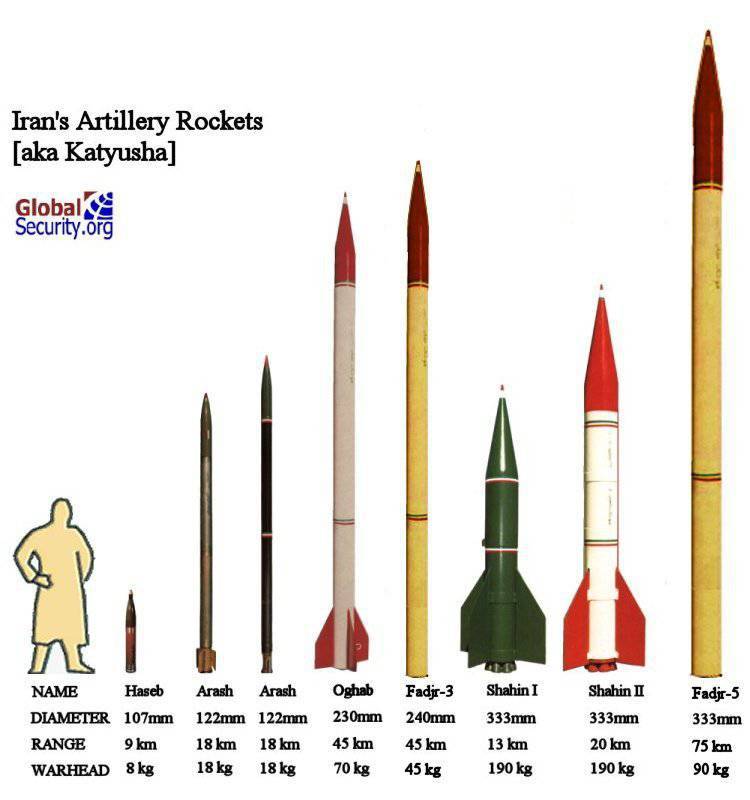
Fajr-xnumx
Simultaneously with Fajr-3, Iranian designers, this time together with the Chinese, began work on the next MLRS, called Fajr-5. The Chinese side handed over to Iran a number of documents on their own project of unguided rockets of the WS-1 family, which to some extent became the prototype for Fajr-5. The aim of the new project was to create a salvo fire system with an even greater firing range of at least 60 kilometers. At the same time, the economic and foreign policy situation demanded that Iranian engineers make the Rassvet-5 as unified as possible with a less long-range installation. As a result of this requirement, among other things, the Fajr-5 went through the same “adventures” with a three-axle wheelbase. Currently, all combat vehicles of this project are assembled on the basis of "Mercedes" model 2631. Auxiliary equipment of the combat vehicle is also similar to the Fajr-3: outriggers for stabilization during firing, an additional cabin for calculation, etc.
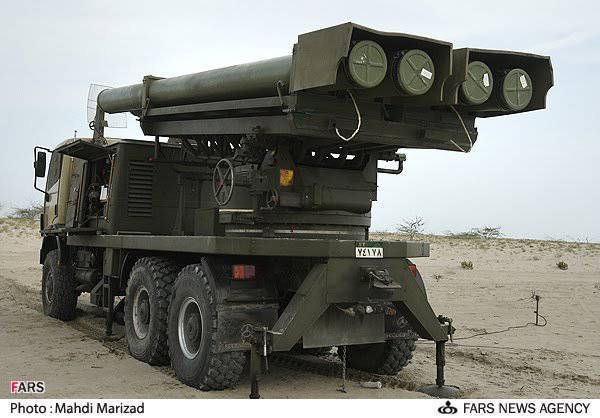
However, the requirements for the firing range and, as a result, the new ammunition led to dramatic changes in the design of the launcher. Calculations showed that the achievement of a given range is possible only with a caliber of at least 300 millimeters. After a series of calculations, the option of an unguided rocket caliber 333 mm was chosen. Large dimensions of ammunition forced to significantly reduce the volume of the volley. While maintaining acceptable dimensions of the launcher, only four launch tubes were placed on it. With the exception of the number of guides and, apparently, some elements, the design of the launcher is similar to the corresponding Dawn-3 unit. The launching of the launcher was initially carried out manually, as on artillery guns. Fajr-5 vertical alignment angles - from horizontal to 57 degrees. Horizontal guidance is possible only within a sector of width 45 ° from the axis of the machine.
The main element of the new long-range MLRS - unguided rocket caliber 333 millimeter. Ammunition length of six and a half meters weighs about 900-930 kilogram. The missile warhead, depending on the type, has a mass of 170-190 kg. Despite the increase in the size of the rocket and the weight of the warhead, the nomenclature of types of the latter remained the same. In accordance with the situation, high-explosive, incendiary, chemical and cluster warheads can be used. In the case of a high-explosive fragmentation variant, the rocket carries an 90 kilogram of explosive. A heavy rocket with a large amount of solid fuel has excellent range performance. The maximum distance it can fly is 75 kilometers (the highest point of the trajectory is at an altitude of about 30 km). Flight stabilization is carried out only due to the rotation of the rocket. This nuance of the project is one of the most controversial - as shown by the calculations of Soviet and American designers, the rocket projectile without any control systems at distances over 55-60 km deviates too much from the aiming point. Fajr-5 missiles are not equipped with any additional control systems, which raises appropriate doubts about the accuracy and accuracy of fire.
All measures to ensure the accuracy of hitting the system "Rassvet-5" touched only the aiming complex. For the first time in Iranian practice, MLRS received an automated control system weapons, which independently calculates the angles of aiming and provides automatic fire with a volley or one shot at a time. The intervals between starts remained the same: 4-8 seconds. During the modernization of the complex Fajr-5 received an updated weapon control system. The main consequence of the modernization is the provision of the possibility of not only determining the parameters of aiming, but also directly turning and pointing the launcher. For this, the latter is equipped with reversal drives; the possibility of manual pickup remains. In addition, the equipment of the upgraded Fajr-5 includes communications equipment that allows you to transfer data on targets and pointing them between the MLRS batteries and command and staff machines. According to the available data, with the presence of new equipment, batteries of multiple launch rocket systems can be dispersed at a distance of up to 20 km from control machines or headquarters.
The exact time of adoption of the Fajr-5 MLRS is unknown. The first copies of these combat vehicles were shown to the public at the beginning of the two thousandth. It soon became known that several installations were transferred to Hezbollah. For some reasons - most likely, this is a small number of delivered vehicles and low accuracy - only isolated instances of the use of these weapons during the Israeli-Lebanese war 2006 are known. The results were not much higher than when using Fajr-3, although a large firing range made it possible to attack targets in a larger area. There is information about further modernization of the salvo fire system, up to the change of its mission. According to some sources, a version of Dawn-5, designed for coastal defense, is being developed or already exists. Probably, it is based on a new anti-ship missile in the dimensions of an unguided ammunition. Otherwise, the shooting of regular rockets at ships, even with radar search and target tracking, looks at least ineffective. Another rumor that did not receive confirmation in official Iranian sources concerns the creation of a full-fledged short-range ballistic missile based on the same Fajr-5. Official data on the modernization of ammunition so far relate to improving the accuracy and a small increase in flight range.
***
A characteristic feature of all the latest Iranian multiple rocket launchers is extensive cooperation with foreign countries in their development. This fact is quite interesting, especially in the light of the "origin" of the Chinese or North Korean experience. It is not hard to guess that the Chinese and Koreans learned to make their own combat vehicles and unguided rockets not without studying the Soviet-made volley fire systems. Thus, Iranian “Sunrises” are to some extent descendants of the Soviet complexes with the BM index in the title. At the same time, the characteristics of the Iranian systems, depending on the model of the combat vehicle and the projectile used, are at a level corresponding to the Soviet MLRS of the past years, and do not constitute something exceptional.
On the materials of the sites:
http://rbase.new-factoria.ru/
http://globalsecurity.org/
http://nti.org/
http://articles.janes.com/
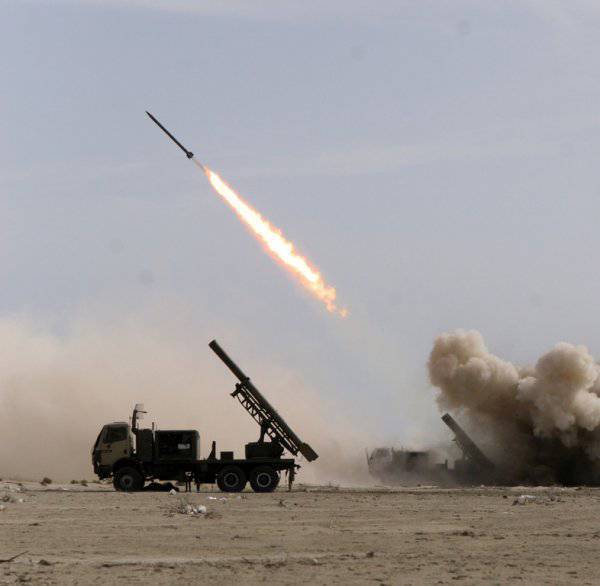
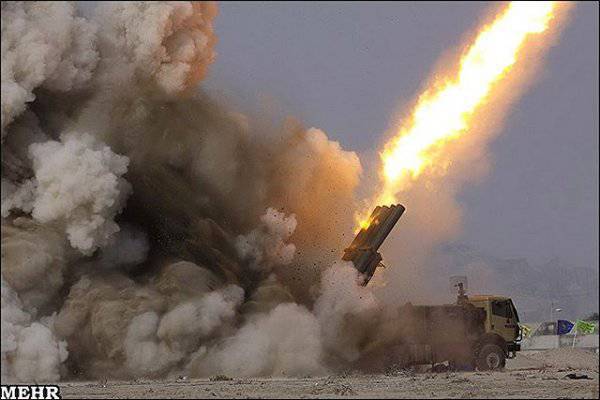
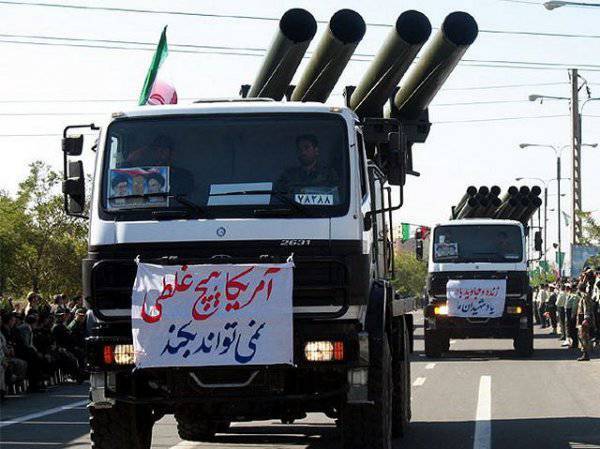
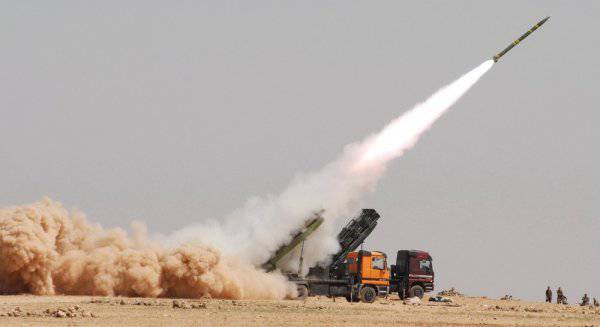
Information